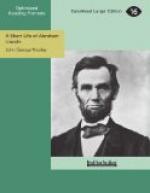The close attention bestowed on its delivery, the hearty applause that greeted its telling points, and the enthusiastic comments of the Republican journals next morning showed that Lincoln’s Cooper Institute speech had taken New York by storm. It was printed in full in four of the leading New York dailies, and at once went into large circulation in carefully edited pamphlet editions. From New York, Lincoln made a tour of speech-making through several of the New England States, and was everywhere received with enthusiastic welcome and listened to with an eagerness that bore a marked result in their spring elections. The interest of the factory men who listened to these addresses was equaled, perhaps excelled, by the gratified surprise of college professors when they heard the style and method of a popular Western orator that would bear the test of their professional criticism and compare with the best examples in their standard text-books.
The attitude of the Democratic party in the coming presidential campaign was now also rapidly taking shape. Great curiosity existed whether the radical differences between its Northern and Southern wings could by any possibility be removed or adjusted, whether the adherents of Douglas and those of Buchanan could be brought to join in a common platform and in the support of a single candidate. The Democratic leaders in the Southern States had become more and more out-spoken in their pro-slavery demands. They had advanced step by step from the repeal of the Missouri Compromise in 1854, the attempt to capture Kansas by Missouri invasions in 1855 and 1856, the support of the Dred Scott decision and the Lecompton fraud in 1857, the repudiation of Douglas’s Freeport heresy in 1858, to the demand for a congressional slave code for the Territories and the recognition of the doctrine of property in slaves. These last two points they had distinctly formulated in the first session of the Thirty-sixth Congress. On January 18, 1860, Senator Brown of Mississippi introduced into the Senate two resolutions, one asserting the nationality of slavery, the other that, when necessary,




